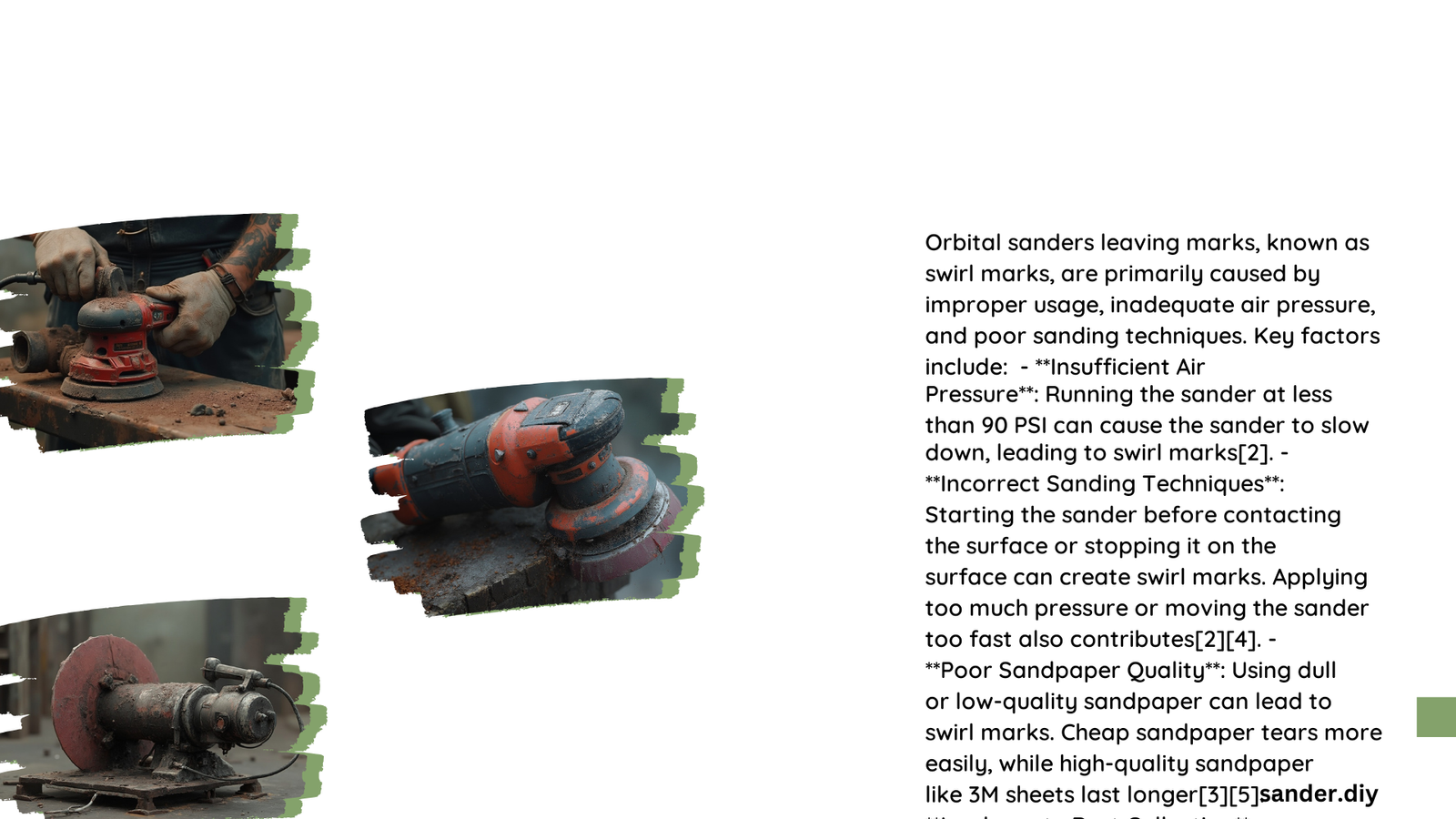Orbital sanders are essential tools for achieving smooth surfaces in woodworking projects. However, they can sometimes leave unwanted marks, affecting the final finish. This article explores the causes of orbital sander marks, provides solutions to remove them, and offers prevention techniques. Understanding these aspects will help woodworkers achieve flawless results in their projects.
What Are the Main Causes of Orbital Sander Marks?
Orbital sander marks, often appearing as swirls or circular scratches, can be caused by several factors:
-
Insufficient Air Pressure: When the air pressure is too low, typically below 90 PSI, the sander may slow down and create swirl marks.
-
Improper Sanding Technique: Starting or stopping the sander while in contact with the surface can leave marks. The golden rule is \”START ON…. STOP OFF.\”
-
Incorrect Grit Progression: Skipping grit sizes or using too coarse a grit can leave deep scratches that finer grits can’t remove.
-
Excessive Pressure: Applying too much downward force can cause the sander to leave marks instead of smoothing the surface.
-
Worn Equipment: Dull sandpaper or worn sander parts can contribute to mark formation.
How Can You Remove Orbital Sander Marks?

Removing orbital sander marks requires a systematic approach:
-
Grit Progression: Start with a coarse grit (e.g., 80) and gradually move to finer grits (120, 150, 180, 220).
-
Hand Sanding: After using the orbital sander, hand sand with the grain using the same grit to blend scratches.
-
Cleanliness: Keep sanding pads clean and free of debris. Vacuum the surface between grit changes.
-
Proper Technique: Move the sander slowly, about one inch per second, maintaining even pressure.
Here’s a table outlining the recommended grit progression:
| Step | Grit | Purpose |
|---|---|---|
| 1 | 80 | Remove deep scratches |
| 2 | 120 | Smooth out 80 grit scratches |
| 3 | 150 | Further refinement |
| 4 | 180 | Prepare for final sanding |
| 5 | 220 | Final smoothing |
What Tools and Products Are Needed for Mark Removal?
To effectively remove orbital sander marks, you’ll need:
- Orbital sander
- Various grit sandpapers (80, 120, 150, 180, 220)
- Hand sanding block
- Vacuum or dust collection system
- Clean cloths for wiping surfaces
How Can You Prevent Orbital Sander Marks?
Preventing orbital sander marks is crucial for achieving a smooth finish. Here are some key prevention techniques:
-
Maintain Proper Air Pressure: Ensure your compressor provides at least 90 PSI and can handle the sander’s demand.
-
Use Correct Technique:
- Start the sander before touching the surface
- Move slowly and steadily
-
Avoid applying excessive pressure
-
Progress Through Grits: Don’t skip grit sizes. Move from coarse to fine systematically.
-
Keep Equipment Clean: Regularly clean sanding pads and replace worn sandpaper.
-
Check Sander Condition: Ensure bearings are in good condition and the sander is properly lubricated.
What Are the Time and Cost Implications of Dealing with Sander Marks?
Dealing with orbital sander marks can impact both time and budget:
Time Estimates:
– Coarse Sanding (80-120 grit): 30-60 minutes
– Intermediate Sanding (150-180 grit): 30-60 minutes
– Fine Sanding (220 grit): 30-60 minutes
– Hand Sanding: 15-30 minutes
Total time for a 100 sq. ft. area: Approximately 2-4 hours
Cost Considerations:
– Sandpaper sheets (multiple grits)
– Replacement sanding pads
– Potential need for additional finishing products
The exact cost will vary based on project size and material quality.
How Do You Identify an Uneven Finish?
Identifying an uneven finish caused by orbital sander marks involves:
-
Visual Inspection: Look for circular scratches or swirl patterns in the wood grain.
-
Touch Test: Run your hand over the surface to feel for inconsistencies.
-
Light Test: Shine a bright light at an angle across the surface to highlight any imperfections.
-
Finish Application: Apply a thin coat of finish – uneven areas will become more apparent.
By understanding the causes of orbital sander marks and implementing proper techniques, woodworkers can achieve smooth, professional-quality finishes on their projects.
References:
1. Uneeda – The End of Swirl Marks From Orbital Sanding
2. Woodweb – Preventing Swirl Marks from Orbital Sanding
3. KM Tools – 2 Steps to Avoid Swirl Marks from Random Orbital Sanders
